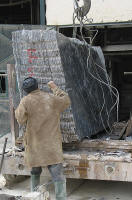| During the Devonian period , Palaeozoic era , approximately 380 millions years ago, the Moroccan Sahara was a floor of a vast prehistoric ocean , the first Mediterranean sea proto -tethys. Because of different natural factors , fish , plants and other old sea animals were fossilized after the withdrawal of the sea . Lack of oxygen , tectonic movements and high temperature are the main natural factors . The south east Moroccan Sahara is now a rich source of a very old and different fossils. |
|
|
|
Geologically speaking , there are many land mines and quarries where fossils are embedded within huge rocks, each quarry has its specific features in term of age , raw material, and colour of fossils. |
|
|
Trilobites , ammonites , goniatites and orthoceras are the main wide spreading fossils in our Sahara . On the one hand , some fossils are embedded within huge and vast marble quarries either from the black or the brown colour . For example the black one is very rich of orthoceras , the squids sediment, and the brown one is very rich of both ammonites and orthoceras .On the other hand, some other fossils are located in mountains that are very rich of limestone rocks such as trilobites . |
| More importantly , the Sahara is very famous with its unique fossilized marble . There are two kinds of marble : the black one is very rich on the way to Merzouga , and the brown one which is 8 km far from Erfoud . The vast quarry is fully rich of the ammonites and orthoceras. |
|
|
Slices of fossil marble after cutting. the next operation is designing and polishing the decortive stones. |
The Factory where we make all kind of decorative stones by fossil marble. |








